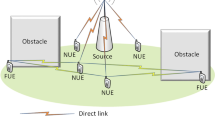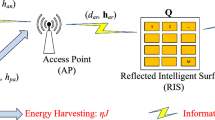Abstract
In this letter, a detailed theoretical analysis of probability distribution and density functions of probability of error in a wireless system is considered. Closed form expressions for distribution and density functions of the probability of error are derived for Weibull fading channels for the cases of (i) No Diversity (ND), (ii) Selection Combining (SC) diversity, and (iii) Switch and Stay Combining (SSC) diversity. Numerical results are plotted and discussed in detail for the various cases.






Similar content being viewed by others
References
W. C. Jakes, Microwave Mobile Communications, 1st edn, Wiley & Sons, Inc, MA, 1974.
N. Sagias, G. Karagiannidis, and G. Tombras, Error-rate analysis of switched diversity receivers in Weibull fading, Electronic letters, Vol. 40, No. 11, pp. 681–682, 2004.
M. Ismail and M. Matalgah, Performance of selection combining diversity in Weibull fading with cochannel interference, EURASIP Journal on Wireless Communications and Networking, Vol. 2007, No. 1, pp. 10–15, 2007.
N. Sagias and N. Tombras, On the cascaded Weibull fading channel model, Journal of the Franklin Institute, Vol. 344, No. 1, pp. 1–11, 2007.
P. Sahu and A. Chaturvedi, Performance analysis of predetection EGC receiver in Weibull fading channel, Electronic Letters, Vol. 41, No. 2, pp. 85–86, 2005.
N. Sagias, G. Karagiannidis, D. Zogas, P. Mathiopoulos, and G. Tombras, Performance analysis of dual selection diversity in correlated Weibull fading channels, IEEE Transactions on Communications, Vol. 52, No. 7, pp. 1063–1067, 2004.
H. Samimi and P. Azmi, An approximate analytical framework for performance analysis of equal gain combining technique over independent Nakagami, Rician, and Weibull fading channels, An International Journal of Wireless Personal Communications, Vol. 43, No. 4, pp. 1399–1408, 2007.
G. Karagiannidis, D. Zogas, N. Sagias, S. Kotsopoulos, and G. Tombras, Equal-gain and maximal ratio combining over nonidentical Weibull fading channels, IEEE Transactions on Wireless Communications, Vol. 4, No. 3, pp. 841–846, 2005.
S. Ikki and M. Ahmed, Performance of multi-hop relaying systems over Weibull fading channels, Springer, Netherlands, 2007.
N. Sagias, P. Varzakas, G. Tombras, and G. Karagiannidis, Spectral efficiency for selection combining RAKE receivers over Weibull fading channels, Journal of the Franklin Institute, Vol. 342, No. 1, pp. 7–13, 2005.
W. Karner, O. Nemethova, and M. Rupp, Link error prediction in wireless communication systems with quality based power control” International Conference on Communications, 2007, pp. 5076–5081, 2007, doi: 10.1109/ICC.2007.838.
M. Ismail and M. Matalgah, Exact and approximate error-rate analysis of BPSK in Weibull fading with co-channel interference, Institute of Engineering and Technology, Vol. 1, No. 2, pp. 203–208, 2007.
Q. Zhang, A simple approach to probability of error for equal gain combiners over Rayleigh fading channels, IEEE Transactions on Vehicular Technology, Vol. 48, No. 4, pp. 1151–1154, 1999.
C. Jie and V. Bhaskar, Error probability distribution and density functions for Rayleigh and Rician fading channels with diversity, International Journal of Wireless Information Networks, Vol. 15, No. 1, pp. 53–60, 2008.
M. Simon and M. Alouini, A unified approach to the probability of error for noncoherent and differentially coherent modulations over generalized fading channels, IEEE Transactions on Communications, Vol. 46, No. 12, pp. 1625–1638, 1998.
A. Poncet, Asymptotic probability density of the generalization error, Proceedings of the 1996 International Workshop on Neural networks for Identification, Control, Robotics, and Signal/Image processing (NICROSP), IEEE Computer Society, p. 66, 1996.
W. Liggett, Estimation of the error probability density from replicate measurements on several items, Biometrika Oxford Journal, Vol. 75, No. 3, pp. 557–567, 1988.
G. Lieberman, Adaptive digital communication for a slowly varying channel, IEEE Transactions on Communication and Electronics, Vol. 82, No. 65, pp. 44–51, 1963.
A. Papoulis, Probability, Random Variables and Stochastic Processes, 3rd edn, McGraw Hill Companies, New York, 1991.
V. Bhaskar and L. Joiner, Variable energy adaptation for asynchronous CDMA communications over slowly fading channels, Journal of Computers and Electrical Engineering, Vol. 31, pp. 33–55, 2005.
J. G. Proakis, Digital Communications,4th edn, McGraw Hill, New York, 2001.
I. Gradshteyn and I. Ryzhik, Table of Integrals, Series, and Products, 5th edn, Academic Press, San Diego, CA, 1994.
Author information
Authors and Affiliations
Corresponding author
Appendix
Appendix
The expression for the error rate of a BPSK system as a function of the received SNR incorporating fading, \(\gamma_b = \frac{\alpha^2 E_b}{N_0},\) is given by [21]
where α is the “faded random variable”, \(Q(x) = \frac{1} {\sqrt{2\pi}} \int\limits_x^{\infty} \exp\left( -\frac{y^2}{2} \right) dy\) is the Q(.) function in probability theory [19]. The unconditional BER for BPSK signaling, P 2, is obtained by averaging P 2(γ b ) over the PDF of γ b , and is given by [21]
where \(\hbox {erf}(.)\) is the error function in probability theory and \(Q(x) = \frac{1}{2} \left( 1 - \hbox {erf}\left( \frac{x} {\sqrt{2}} \right) \right)\) [19].
Making change of variables in the integral of (13) with \(t = \frac{\gamma_b^p}{2\sigma^2}\) and \(dt = \frac{p \gamma_b^{p-1}} {2\sigma^2}d\gamma_b,\) we have
Now, consider the infinite series expansion for \(\hbox{erf}(x)\) from [22] given by
Substituting (15) into (14), rearranging and simplifying, we have
where \({\gamma_c}=2\sigma^2\) is the SNR without fading. In our case, we can consider \({\gamma_c}=\hbox{SNR}.\) So, \(g^{-1}(y) \equiv \hbox {SNR}.\)
Let x ≡ γ c . Then, \(\frac{\partial g^{-1}(y)}{\partial y} = \frac{\partial x}{\partial y}.\) From (16), we have
Thus, \(c_1(y) = -\frac{1}{\frac{\partial y}{\partial \gamma_c}},\) and it is substituted in Eqs. 7, 9 and 11 to compute the PDF of the probability of error in Weibull fading channels in the cases of no diversity, SC diversity, and SSC diversity, respectively.
Rights and permissions
About this article
Cite this article
Bhaskar, V. Error Probability Distribution and Density Functions for Weibull Fading Channels With and Without Diversity Combining. Int J Wireless Inf Networks 16, 91–97 (2009). https://doi.org/10.1007/s10776-009-0087-z
Received:
Accepted:
Published:
Issue Date:
DOI: https://doi.org/10.1007/s10776-009-0087-z




